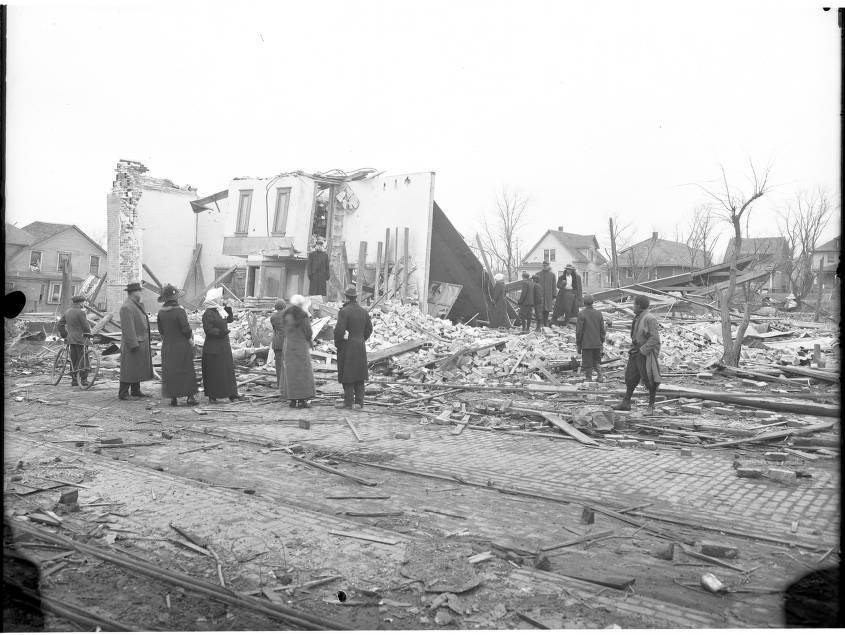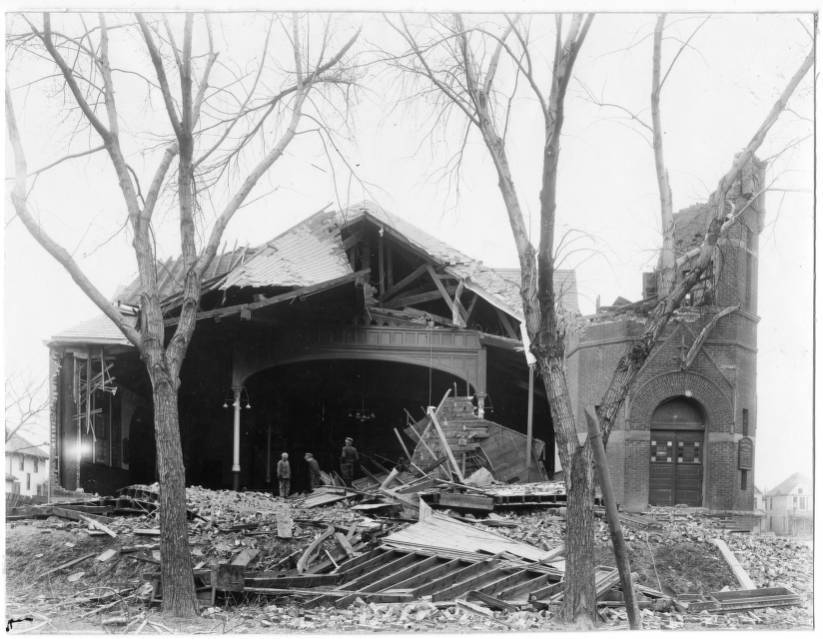Easter Sunday - March 23, 1913 - will be a day long remembered in Nebraska and Iowa. That day, multiple violent tornadoes devastated entire communities in the region. The most violent of them went directly through Omaha, causing a path of utter devastation. However, the Omaha tornado was but one of several violent tornadoes that struck close to one another. Towns such as Craig, Yutan, and Berlin (Otoe) outside of Omaha in Nebraska suffered extensive damage; as did Council Bluffs, Woodbine, Gray, and others in western Iowa.
This short series on This Week in Weather History will look in detail not just at the Omaha tornado, but at the entire day of destruction for Nebraska and Iowa. Part 1 will establish the background of the world of 1913, what Omaha and the US were like, the state of meteorology, and the atmospheric conditions that led to such a violent tornado outbreak. Part 2 begins by looking at the individual tornadoes, focusing on the tornadoes of eastern Nebraska. Part 3 examines the tornadoes recorded and unrecorded in western Iowa. Finally, part 4 (this part) takes a detailed look at the tornado that devastated Omaha. Take a look back at the tornado outbreak which shaped a region, 110 years ago this week.
TOUCHDOWN: RALSTON
In 1913, Ralston was only a year old. It was largely an industrial city with multiple factories sustaining growth. Only a few hundred lived in the region in 1913. Unlike today, where Ralston has been consumed by the expansion of the Omaha metro, 110 years ago it was several miles removed from the city, a rural community.
It would face its first major test that Easter Sunday when the tornado touched down in Sarpy County. If it were to touch down today, it likely would have around the intersection of Portal Rd and 96th St in Papillion/La Vista. It quickly raced to the northeast right into the heart of the business district of Ralston. Within a matter of minutes, nearly the entire young town was wiped off the map as businesses and homes were nearly ruined. In Ralston, 7 people were killed and many others were injured.

Among the areas of great wreckage was a large furniture factory. An ice box, where upwards of $500,000 in ice (roughly $15,000,000 in 2023) was stored. The tornado tore the roof off, exposing the ice to the outdoors. Thankfully, the cold front following the storm brought temperatures cold enough to keep much of the ice frozen, so losses in the ice were not as significant as they could be.

CENTER, LEAVENWORTH, AND FARNAM STREETS
Although today the region bounded by 72nd to 42nd and L to Farnam St is populated by neighborhoods and businesses, in 1913 this was mostly rural farmland. After striking Ralston, the tornado continued northeast into this area. Farmsteads were left devastated, livestock killed, and other buildings suffered extensive damage. Many trees were snapped, and other significant damage was done to this region.

The tornado entered Omaha around the intersection of 42nd and Farnam, where many residences and businesses were extensively damaged. This was a relatively new development, with many of these homes occupied by the more prominent members of Omaha society. These homes were lifted off their foundation, lost their roofs, and suffered other damage.

A Children's institution was hit, and the brick building suffered damage. An auto garage at 40th and Farnam was wrecked, with many automobiles blown onto the roof and even the trees nearby.

JOSLYN CASTLE
Constructed 10 years before 1913, George and Sarah Joslyn's building was the finest in Omaha. The building cost an estimated $7,000,000 in today's money to build, with extensive grounds. It quickly became an attraction, with tourists coming far and wide to see the magnificent structure. However, the Easter Sunday tornado was also a visitor to the castle, and it left much of it in ruins.

The actual structure of the castle was relatively minor, except for the conservatory which was more heavily damaged. Sarah Joslyn had imported several exotic plants from across the world, which needed specific conditions to survive. When the tornado damaged the conservatory, most of the plants died. Likewise, much of the grounds was chewed up, with large trees strewn across the grounds. George Joslyn would claim that it would take 15 years for the grounds to be rebuilt.
BEMIS PARK
After hitting Joslyn Castle, the tornado continued northeast into the Bemis Park neighborhood. Here it began its arc of destruction which would continue unabated until crossing into Iowa. Multiple trees in Bemis Park were twisted, snapped, and uprooted. One of the finest parks in Omaha was left looking like a war zone.

The neighborhoods surrounding Bemis Park also suffered extensive damage. Near 33rd and Charles St, homes were destroyed so thoroughly it looked as if nothing had been built.

Across the street from Bemis Park was the Sacred Heart Convent of Omaha, today Duchesne Academy. That evening, the nuns were gathering for an evening service when the tornado struck. The entire north face of the large brick building was destroyed, taking several months to rebuild.

In this neighborhood is one of the most extraordinary survival stories of the tornado. Schoolteacher Beulah Adams, wearing her Sunday clothes, was walking home in Bemis Park when the tornado hit. On a streetcar just seconds before, Beulah saw the tornado and jumped to the ground where the tornado passed over her. She looked up into the eye of the storm, seeing nothing but blackness and debris. She survived the tornado, writing a descriptive letter to her mother about the tornado, although her Sunday clothes were torn up.
24TH AND LAKE
The tornado continued its track into North Omaha, heading right for the hub of the region, 24th and Lake. Normally, it is a busy intersection, but on Easter Sunday it was less so as many went home for dinner. The destruction at 24th and Lake was perhaps the heaviest area of damage in Omaha, where several brick buildings were heavily damaged. Stores ruined, entertainment centers damaged, and other buildings lost.

At the German Lutheran Church at 28th and Parker St, a wedding ceremony was being held. They heard the storm approaching, the newlyweds said their vows quickly and sped from the church in an automobile. The guests at the wedding ran to the basement when the Church collapsed on them, but all of them survived. A few weeks later, the wedding was held again to make sure the marriage was official.

At the Diamond Motion Picture Theater, dozens of people were present watching Wilson's inauguration speech when they felt the storm coming. Feeling the shaking, many dove under their seats just seconds before the roof collapsed on them. Luckily, the roof settled on the seats, saving all of the occupants in the theater.

In the same area as the theater, a different outcome came out, the greatest tragedy in the Omaha tornado. At the Idlewild Pool Hall, over a dozen people were in the building when the tornado hit. Somebody brought the people into the basement, but the pool hall collapsed on the people below ground. The few who survived recounted how the pool hall lifted, and then dropped on the inhabitants below. The tragedy at the Pool Hall was the largest loss of life in the entire tornado, with only 3 people of over 20 surviving.

KOUNTZE PLACE
After devastating 24th and Lake, the tornado continued northeast into the Kountze Place neighborhood. Many of the homes in this neighborhood suffered damage.

At 22nd and Binney sat the Trinity United Methodist Church, today the location of the Sacred Heart Catholic Church. The Trinity United Methodist Church was heavily damaged, with its steeple crashing to the ground, by the tornado.

FINAL STOP: CARTER LAKE
After leaving the heart of North Omaha, the final stop for the tornado on the west side of the Missouri River was Carter Lake. The tornado passed over the northern edge, damaging many homes. A final note of significant damage was to the Illinois Central Railroad Bridge which spanned Carter Lake. The tornado ripped through the center of the bridge, throwing the trestle into the lake below.

AFTERMATH, RELIEF, AND RECOVERY
When residents went to bed on March 23, those not affected by the tornado outbreak were aware something had happened, but they had no idea of the extensive damage. On the morning of March 24, residents began to understand the full scope of the tornado that ripped through town. Original newspaper estimations of the dead ranged into the hundreds, but would eventually come down to around 100. The official death toll in the Omaha tornado was 103, 7 in Ralston, 3 in Iowa, and the rest in Omaha. At this toll, not only is it the deadliest tornado in Nebraska state history, but it is the 13th deadliest tornado in United States history.
The Yutan and Berlin tornadoes are the 2nd and 3rd deadliest tornadoes in Nebraska state history, respectively.
In the days after the tornado, letters of condolences and offers of aid poured into Omaha by the dozens. President Wilson telegraphed the mayor of Omaha, James Dahlman, asking him if the government could do anything to help. The mayor declined government aid, mainly because he had no idea of the scope of the devastation. Relief poured in from all over the country, even cities in Canada sent money to Omaha to help the rebuilding process.

As Omaha slowly rebuilt, Ralston managed to recover rapidly. By 1914, just one year later, the business district in Ralston was mostly rebuilt. At the same time, much of Omaha recovered as well. As for Craig, Yutan, Berlin, Woodbine, Council Bluffs, Harlan, and every other location in Nebraska and Iowa, things improved remarkably.
It is impossible to estimate the exact extent of the loss that eastern Nebraska and western Iowa suffered on March 23, 1913. It is without a doubt the most devastating tornado outbreak in the region's history, something that no storm had even come close to. The Omaha tornado of 1975 was devastating, but the widespread nature of 1913 made it worse. Easter Sunday 1913 lives on in the memories and archives of eastern Nebraska and western Iowa.




